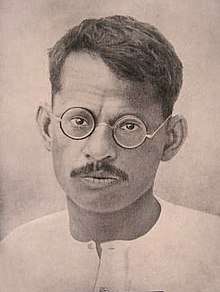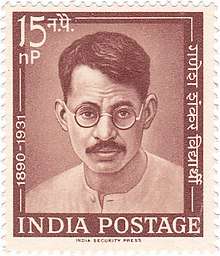Ganesh Shankar Vidyarthi
Ganesh Shankar Vidyarthi (26 October 1890 – 25 March 1931) was an Indian journalist, a leader of the Indian National Congress[1] and an independence movement activist. He was an important figure in the non-cooperation movement[2] and the freedom movement of India, who once translated Victor Hugo's novel Ninety-Three,[3] and is mostly known as the founder-editor of the Hindi language newspaper, Pratap.[4][5][6]
Ganesh Shankar Vidyarthi | |
|---|---|
 1940s portrait | |
| Born | 26 October 1890 Prayagraj, United Provinces, India |
| Died | 25 March 1931 (aged 40) |
| Occupation | Journalist |
| Years active | 1890–1931 |
| Title | Editor- Pratap (1913–1931) |
Life
Ganesh Shankar was born in a Hindu Kayastha family at Hathgaon/Hathgam in Fatehpur District . This is also the birthplace of renowned Urdu poet Shri Iqbal Verma and it is said, this was populated by Saint Parashar. His father Jai Narain, also spelled as Jainarayan, was a teacher in a middle school namely Anglo Vernacular School[7] in Mungaoli which is now the tehsil of Ashoknagar district of Madhya Pradesh. He was poor but a deeply religious Hindu and dedicated to high ideals. It was under him that Ganesh Shankar received his early schooling and passed the high school examination privately in 1907 after studying in Mungaoli and Vidisha. His admission register is available in this school. He could not study further due to poverty and became a clerk in the currency office and later a teacher in high school in Kanpur. At age 16, he also wrote his first book Hamari Atmogsargart and wed his wife Chandraprakashwati Vidyarthi on 4 June 1909.[8]
His real interest, however, was in journalism and public life and he came early under the influence of the nationalist upsurge, which was taking place in the country. He became an agent of the well-known revolutionary Hindi and Urdu journals – Karamyogi and Swarajya and also began to contribute to them. He adopted the pen-name 'Vidyarthi' – the seeker of knowledge. He attracted the notice of Pt. Mahabir Prasad Dwiwedi, the doyen of Hindi journalism who offered him the job of a sub-editor in his famous literary monthly, "The Saraswati", in 1911. Ganesh Shankar, however, was more interested in current affairs and politics and therefore joined the Hindi weekly "Abhyudaya" a political journal of the time. He thus served his apprenticeship under two of the greatest figures in Hindi literature and journalism of the time.
In 1913 Ganesh Shankar came back to Kanpur and launched his career of a crusading journalist and freedom fighter, which was only to end with his death 18 years later. He founded 'Pratap', his famous revolutionary weekly, which identified itself with the cause of the oppressed wherever they might be and Pratap would prove to be widespread as its circulation jumped from five hundred in 1913 to six hundred in 1916.[9] It was through this paper that he waged his famous fights for the oppressed peasants of Rae Bareli, the workers of the Kanpur mills and the downtrodden people of Indian states. During the course of these fights he had to face numerous prosecutions, pay heavy fines and suffer five prison sentences. On 11 January 1915, he said the following quote:[10]
Now the time has come for our political ideology and our movement no [to] be restricted to the English-educated and to spread among the common people [samanya janta], and for Indian public opinion [lokmat], to be not the opinion of those few educated individuals but to mirror the thoughts of all the classes of the country...democratic rule is actually the rule of public opinion".
Later on 31 May, he also said:
The much-despised peasants are our true bread-givers [annadata], not those who consider themselves special and look down upon the people who live in toil and poverty as lowly beings
He first met Gandhiji in 1916 in Lucknow and threw himself whole-heartedly in the national movement. He took a leading part in the Home Rule Movement of 1917–18 and led the first strike of textile workers in Kanpur. In 1920 he launched the daily edition of Pratap and it was in this year that he was sentenced to two years rigorous imprisonment for championing the cause of peasants of Rae Bareli. He was released in 1922 and almost immediately sent to jail again, for delivering a "seditious" speech as the President of the Provincial Political Conference at Fatehgarh. In 1924, he met and protested along with Bhagat Singh,[11] who became a close colleague and friend.[12][13] He would also later associate himself with Chandra Shekhar Azad.[14] Singh was released in 1924, greatly shattered in health, but he knew no respite and founded a short-lived union[1] and also launched himself in the preparation for the Congress Session at Kanpur in 1925.
In 1925, when the Congress decided to contest elections of Provincial Legislative Councils and organised the Swaraj Party, Ganesh Shankar won a resounding victory on its behalf, from Kanpur and served as a Member of the U.P. Legislative Council until 1929 when he resigned at the behest of the Congress. In 1925, after Gandhi founded the Beech Wala Chowk temple in Kanpur, Vidyarthi frequently used it to host meetings.[15] In 1926, Vidyarthi, who was considered an important member of Congress, encouraged Shiv Narayan Tandon to also join Congress. In 1928, he also founded the Mazdur Sabha and led it until his death in 1931.[4] In 1929 he was elected the President of the U.P. Congress Committee and was appointed the first 'dictator' to lead the Satyagrah movement in U.P. He was a supporter of the Hindi language and attended the Hindi Sahitya Sammelan conference in 1930 in Gorakhpur[16] and in March 1930 at Shraddhanand Park in New Delhi.[6] That same year, he was arrested and sent to jail again. He was released on 9 March 1931 under the Gandhi-Irwin Pact.
While he was about to proceed to Karachi to attend the Congress Session, Kanpur fell into an orgy of communal rioting. Ganesh Shankar Vidyarthi threw himself in the midst of furious mobs and saved the lives of thousands of innocent persons belonging to both the Hindu and Muslim communities and it was on this mission of mercy that he was butchered to by rioting mob only to be found few days later near litter where it took some time to identify him due to multiple wounds by knife.[1][17][18]
Mahatma Gandhi paid him the following tribute in the pages of 'Young India'. "The death of Ganesh Shankar Vidyarthi was one to be envied by us all. His blood is the cement that will ultimately bind the two communities. No pact will bind our hearts. But heroism such as Ganesh Shankar Vidyarthi showed is bound in the end to melt the stoniest hearts, melt them into one. The poison has however gone so deep that the blood even of a man so great, so self-sacrificing and so utterly brave as Ganesh Shankar Vidyarthi may today not be enough to wash us of it. Let this noble example stimulate us all to similar effort should the occasion arise again". Author Siyaramsharan Gupta also made Vidyarthi the subject of the works Atmotsarg Patheya and Mrinmoyee Atmotsarg.[19]
In 2006, there was controversy involving an unauthorized unveiling of statue in Mungawali, Madhya Pradesh honoring Vidyarthi by Member of Parliament of INC, Jyotiraditya Madhavrao Scindia. The police and state government claimed it was unauthorized and seized the statue despite local congressman and journalists insisting it be restored.[20] In 2007, journalist Alok Mehta was awarded the Ganesh Shankar Vidyarthi Award by the Makhanlal Chaturvedi National University of Journalism and Communication.[21]
Honors

- Ganesh Shankar Vidyarthi Puraskar is given to renowned journalists by honourable President of India every year from 1989.
- The Ganesh Shankar Vidyarthi Memorial (GSVM) Medical College Kanpur is named in his remembrance.
- Ganesh Chowk, a square is named after him in the heart of the city of Gorakhpur.
- Phool Bagh, earlier Queen's Park in Kanpur is also called as Ganesh Vidyarthi Udyan.
- The Ganesh Shankar Vidyarthi Inter College (GSVIC) GSV Inter College Kanpur is named in his remembrance.
- The Ganesh Shanker Vidyarthi Inter College (GSV Inter College Hathgaon-Fatehpur) is named in his remembrance.
- Ganesh Shanker Vidyarthi Smarak Inter College (GSVS Inter College Maharajganj, UP) is named after his remembrance.
- On 18 July 2017, the Uttar Pradesh government has renamed Kanpur Airport as Ganesh Shankar Vidyarthi Airport to pay respect to his contribution for the independence of India.
References
| Wikimedia Commons has media related to Ganesh Shankar Vidyarthi. |
- Gooptu, Nandini (2001). The Politics of the Urban Poor in Early Twentieth-Century India. Cambridge University Press. pp. 90–376. ISBN 978-0521443661.
- Pandey, Gyanendra (2002). The Ascendancy of the Congress in Uttar Pradesh. Anthem Press. pp. 37–77. ISBN 978-1843317623.
- Simon, Sherry; St. Pierre, Paul (2000). Changing the Terms: Translating in the Postcolonial Era. University of Ottawa Press. p. 89. ISBN 978-0776605241.
- Brass, Paul R. (1965). Factional Politics in an Indian State: The Congress Party in Uttar Pradesh. University of California Press. pp. 169–196.
- Mukul, Akshaya (3 November 2015). Gita Press and the Making of Hindu India. HarperCollins. ISBN 978-9351772316.
- Gould, William (15 April 2004). Hindu Nationalism and the Language of Politics in Late Colonial India. Cambridge University Press. pp. 61–100. ISBN 978-1139451956.
- Neeraj Shukla. Ganesh Shankar Vidharthi Samajik Chetna Ke sarthi. Lokvani Prakashan Delhi. p. 25. ISBN 9789381487853.
- "Ganesh Shankar Vidyarthi: Penman in the battle against communalism". merinews.com. 18 April 2015. Retrieved 10 September 2015.
- Burton, Antoinette; Hofmeyr, Isabel (2014). Ten Books That Shaped the British Empire: Creating an Imperial Commons. Duke University Press. ISBN 978-0822375920.
- Parameshwar Gaonkar, Dilip (2007). Cultures of Democracy. Duke University Press. p. 48. ISBN 978-0822366720.
- Ahuja, M. L. (2008). Eminent Indians: Revolutionaries. Rupa & Co. ISBN 978-8129113955.
- Bakshi, S. R. (2001). Early Aryans to Swaraj. Sarup & Sons. pp. 302–304. ISBN 978-8176255370.
- Massey, Reginald (2014). Shaheed Bhagat Singh and the Forgotten Indian Martyrs. Abhinav Publications. p. 177.
- Singh Rana, Bhawan (2005). Chandra Shekhar Azad (An Immortal Revolutionary of India). Diamond Pocket Books. pp. 53–57. ISBN 978-8128808166.
- "Midnight flag hoisting at Beech Wala Chowk Manir". timesofindia.indiatimes.com. 15 August 2015. Retrieved 10 September 2015.
- Kothari, Rita (1998). Modern Gujarati Poetry: A Selection. Sahitya Akademi. p. 48. ISBN 978-8126002948.
- Gandhi, Rajmohan (2006). Gandhi: The Man, His People, and the Empire. University of California Press. p. 327. ISBN 978-0520255708.
- Bakshi, S. R. (1988). Gandhi and the Mass Movements. Atlantic Publishers. p. 198.
- Premshankar (2006). Siyaramsharan Gupta (Hindi Writer). pp. 5–94. ISBN 978-8126013401.
- "Unveiling of Vidyarthi's statue runs into trouble". Hindustan Times. 9 June 2006. Archived from the original on 1 March 2016. Retrieved 10 September 2015.
- "Award for Alok Mehta". thehindu.com. 18 March 2007. Retrieved 11 September 2015.